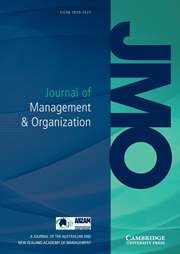Crossref Citations
This article has been cited by the following publications. This list is generated based on data provided by
Crossref.
Krzeminska, Anna
Austin, Robert D.
Bruyère, Susanne M.
and
Hedley, Darren
2019.
The advantages and challenges of neurodiversity employment in organizations.
Journal of Management & Organization,
Vol. 25,
Issue. 04,
p.
453.
2020.
Culture, Mind, and Brain.
p.
363.
Cascio, M. Ariel
2020.
Culture, Mind, and Brain.
p.
477.
Kirmayer, Laurence J.
Worthman, Carol M.
Kitayama, Shinobu
Lemelson, Robert
and
Cummings, Constance
2020.
Culture, Mind, and Brain.
Rottier, Helen
and
Gernsbacher, Morton Ann
2020.
Disability Alliances and Allies.
p.
155.
Stošić, Jasmina
2021.
Inclusion from the Perspective of Pupils with Autism.
Društvene i humanističke studije (Online),
Vol. 6,
Issue. 4(17),
p.
493.
Wen, Benjamin
van Rensburg, Henriette
O’Neill, Shirley
and
Attwood, Tony
2023.
Autism in the Australian workplace: the employer perspective.
Asia Pacific Journal of Human Resources,
Vol. 61,
Issue. 1,
p.
146.
Khan, Maria Hameed
Grabarski, Mirit K.
Ali, Muhammad
and
Buckmaster, Stephen
2023.
Insights into Creating and Managing an Inclusive Neurodiverse Workplace for Positive Outcomes: A Multistaged Theoretical Framework.
Group & Organization Management,
Vol. 48,
Issue. 5,
p.
1339.
Garner, Andrea
Burns, Pippa
Carolan, Lucy
Price, Tyler
and
Pearson, Zac
2024.
Good business: creating an autism-friendly community using the SERVICE principles.
Disability & Society,
Vol. 39,
Issue. 3,
p.
696.
van Rijswijk, Jan
Curșeu, Petru Lucian
and
van Oortmerssen, Lise A.
2024.
Cognitive and Neurodiversity in Groups: A Systemic and Integrative Review.
Small Group Research,
Vol. 55,
Issue. 1,
p.
44.
Opie, Jessica E.
Vuong, An
Maylea, Christopher
Khalil, Hanan
Brown, Louis
Macafee, Alexandra
Ah Ket, Blossom
Pearce, Natalie
Guerin, Nicola
and
McIntosh, Jennifer E.
2024.
Understanding Lived Experience Organizations: A Systematic Scoping Review of Organizational Elements and Characteristics.
Psychiatric Services,
Vol. 75,
Issue. 12,
p.
1227.
Ezerins, Maira E.
Simon, Lauren S.
Vogus, Timothy J.
Gabriel, Allison S.
Calderwood, Charles
and
Rosen, Christopher C.
2024.
Autism and Employment: A Review of the “New Frontier” of Diversity Research.
Journal of Management,
Vol. 50,
Issue. 3,
p.
1102.
van Rijswijk, Jan
Curşeu, Petru L.
and
van Oortmerssen, Lise A.
2024.
Neurodivergence and Boundary Spanning as Predictors of Social Skills and Diversity Climate.
Administrative Sciences,
Vol. 14,
Issue. 11,
p.
285.
Bapuji, Hari
Ertug, Gokhan
Soundararajan, Vivek
and
Shaw, Jason D.
2024.
Invisible Inequalities: Barriers, Challenges, and Opportunities.
Journal of Management,
Vol. 50,
Issue. 3,
p.
835.
Attenborough, Mark B.
and
Dimoff, John D.
2025.
Autism × Social Psychology: A Collaboration Whose Time Has Come.
Social and Personality Psychology Compass,
Vol. 19,
Issue. 4,
Comer, Debra R.
2025.
Employee Misfit.
p.
189.
Jamil, Rossilah
Sin Ru, Ong
and
Rocco, Tonette S.
2025.
Mapping of Neurodiversity and Work: Review and Research Agenda.
New Horizons in Adult Education and Human Resource Development,
Gottardello, Debora
Calvard, Thomas
and
Song, Ji‐Won
2025.
When Neurodiversity and Ethnicity Combine: Intersectional Stereotyping and Workplace Experiences of Neurodivergent Ethnic Minority Employees.
Human Resource Management,
Vol. 64,
Issue. 3,
p.
841.

